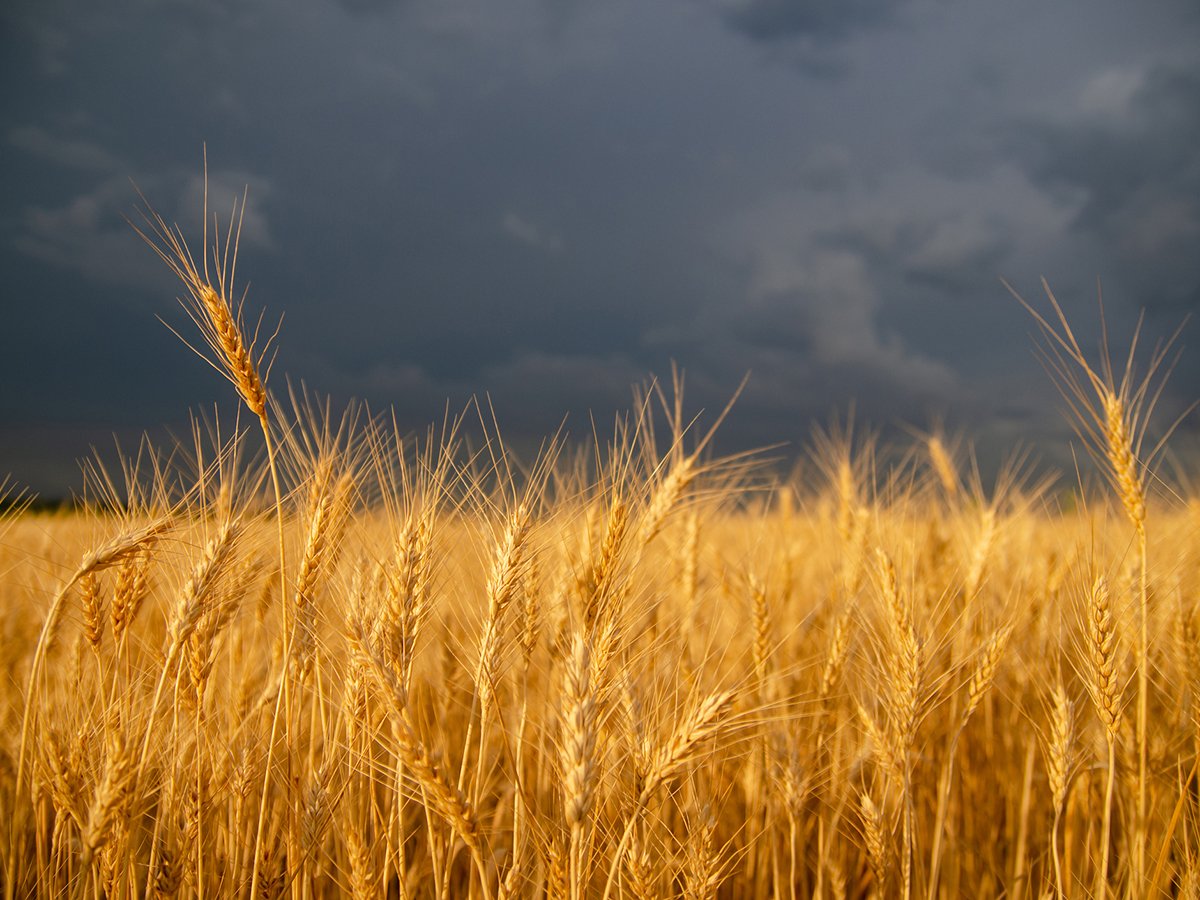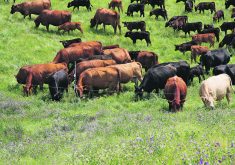Not adding up
Technology has improved immensely in the last decade and because of
this Canadians have a wealth of information that was not available to
them previously.
Rural Canada is populated with intelligent, forward-thinking people who
are more than capable of grasping complicated business issues. We now
demand more detailed information from the directors of the Canadian
Wheat Board, who work for us and manage billions of dollars of our
money.
CWB borrowing is an issue that is brought up often. CWB director Ken
Read Also

Late season rainfall creates concern about Prairie crop quality
Praying for rain is being replaced with the hope that rain can stop for harvest. Rainfall in July and early August has been much greater than normal.
Ritter recently explained, “this amount simply reflects the numerous
rollovers of funds required to meet the CWB’s short term cash needs as
well as to capitalize on opportunities to maximize farmers returns.”
This statement is important when trying to analyze the following
information.
In 1991 the total borrowings of the CWB shown in the Public Accounts of
Canada was $21 billion. They were handling 31,197,242 tonnes of grain
with a sales value of $3.5 billion and they retained a balance on
borrowings of approximately $6.4 billion.
In 1998 the total borrowings were $185 billion. They were handling
21,668,373 tonnes of grain with a sales value of $4.7 billion and they
retained a balance on borrowings of approximately $6.6 billion.
In 2000 the total borrowings were $85 billion. They were handling
23,628,850 tonnes of grain with a sales value of $4.5 billion and they
retained a balance on borrowings of approximately $7 billion.
When I look at 1991 and see that it only took $21 billion in
rolled-over funds to meet the CWB’s short-term cash needs and
capitalize on the opportunities to maximize farmers’ returns when they
handled 31,197,242 tonnes of grain and yet in 1998 it took $185 billion
to do the same job when they only handled 21,668,373 tonnes of grain, I
have to wonder why the short-term cash needs of the CWB … have risen
so drastically over the years.
Does this reflect a dramatic increase in operating costs and other
expenses of the CWB?
If not, what would be the need for this increase in short-term funding?
Sales of grain on credit only account for five to 15 percent of all
grain marketed by the CWB on a yearly basis but in 1991 credit grain
sales accounted for a whopping 30 percent of total sales.
In spite of this, the borrowings in 1991 remained low. This does not
add up. More detailed answers and increased communications are
definitely needed here.
– Lynda Swanson,
Elnora, Alta.
Producer cars
I am very disappointed to see these attacks on producer car loading
facilities by the Western Grain Elevators Association and the Canadian
Grain Commission and also your editorial staff.
Producers need these facilities in order to get cars. Trains will not
go down branch lines for one or two cars. We need to be able to fill 10
or 22 or more cars at a time.
We only have a limited amount of time to fill these cars. If the
weather turns bad, it may be impossible to fill the cars on time.
These facilities do not buy or sell the farmers’ grain. They simply
perform the service of loading the car. The grain is graded and
inspected by the Canadian Grain Commission at port. This guarantees the
quality protection our system needs.
The farmer understands the risks and benefits of ordering producer
cars. The grain companies understood that when they consolidated, they
could lose customers.
In fact they were told by the farmers that they would. They should
accept the consequences of doing what they did.
If elevator closures bring more efficiency to the grain handling
system, the WGEA has nothing to worry about. A farmer will usually go
to the lowest cost system.
Finally, if the WGEA truly wanted to help the farmers, they should give
us fair grades, dockage and a lower cost system.
Simply put, the elevators charge us too much for using their elevators.
– George Rapley,
Climax, Sask.
Common sense
The wheat pool once was 100 percent farmer owned. Where did they go
wrong?
Well, I think my grandfather would turn over in his grave since I
believe he was on the board for quite a few terms in the late ’30s and
early ’40s and I’m sure he would also be disappointed at me since I
pretty well quit using the Pool in the middle ’80s for the simple
reason the farmer local meetings were pretty well a waste of time for
the farmer and the delegate.
The brass or CEO were already making all the decisions without the
approval of the shareholders and were doing so probably since the
mid-’70s, and the last two presidents should be held accountable for
that if the Pool falls ….
They were one of the key factors when they finally agreed to let the
Crow go, which was the most devastating thing to all farmers and it
will never, ever be the same and if that wasn’t enough they then took
the opportunity to do the final touch and joined in with the railways
to abandon all the short lines so they could tear down all their
elevators, and lo and behold, the farmer just going to support them
even if it meant longer hauls and surely you would then still help us
out by taking a grade or two less so we can try and steal some new
customers away from the opposition.
Well, my friends, you lost a pile of customers. …
Of course there’s the grave digger cement thing at Hodgeville where
they put in a 50-mile siding with heavy steel and when the oppositions
all put theirs in Swift Current.
Then of course the one at Smiley and Coleville where they put in heavy
steel a few years prior and we were guaranteed until the year 2000 and
the boys sure as pudding had to agree there with the railroad because
it’s been gone for at least six years.
No, I think I’ll go back to school and see if I can figure this one out
and I would if I knew they could teach a degree in common sense.
– Arnold Elliott,
Smiley, Sask.
Need change
We have problems. Good grief, we had as many people living here
(Saskatchewan) in 1929 as we do now.
Where are they all? One border to the west.
All our best and brightest are going west with their education,
motivation and attitude.
Most adults from Saskatchewan reading these posts have family and
friends who have moved there. I know I have….
People just don’t want to be here anymore. Our statistics are skewed as
well. We have no brutally big urban centres, yet Regina and Saskatoon
are the crime capitals of Canada.
We top the list for teen pregnancy, teen suicide, car theft – and yes,
there are people, lots of people, on welfare.
The farm sector is in the … (toilet), with little or no interest
coming from the feds or the public. We have oppressive taxes, the
ever-present fear of our government funding our competition, an aging
work force – those who choose to stay, anyway – and an ineffective
socialist government that is, simply put, old world.
The very people that could break us out of the status quo have moved
away. Their votes have gone elsewhere, while the votes here couldn’t be
moved with a bulldozer. Go figure.
Many people go on and on about saving health care and education. I
suggest to them that they should worry about the state of our
provincial economy first, for without it everything, including the two
areas mentioned, are finished.
When are the voters of this province going to accept the fact that the
‘status quo’ is just not working? The world is blowing by us as we
desperately hang on to our little island of socialism.
Our government is stuck on a never-ending episode of Gilligan’s Island
where the title characters can’t accept the fact that you can’t build a
submarine with bamboo.
We need change. We need it now. We need new faces with bold new ideas.
We need to break new dirt and we need to do it with a different
attitude.
We need to forge a new relationship between all the people in this
province, young or old, urban or rural, left or right. We need a brave
new direction and we need it now.
– Bill Garratt,
Abernethy, Sask.
Still minister
As a grain and livestock producer working full time off the farm, it
overwhelms me that with the outcry of farmers and various lobby groups
over the past number of years that this individual (federal agriculture
minister Lyle Vanclief) be left at his position.
Certainly Mr. (Jean) Chrétien made it quite clear during the last
federal election that those from western Canada are different.
He clearly shows this by having Mr. Vanclief, who could not make a go
of it on his own farm, and became involved in politics, become his own
agriculture minister to say no to us, or to say not all those who farm
can survive.
Those who have lasted this long are not poor managers. We simply find
ourselves being (abused) by a government who would rather see a number
of corporation farms survive, or those heavily involved with the large
chemical companies.
We have Mr. (Ralph) Goodale who was elected in an urban riding to
represent the Canadian Wheat Board and the western Canadian farmer, who
sits on the wall refusing to say or do anything, and Mr. Vanclief with
his arrogant attitude and farm programs which do little or nothing.
Either way, agriculture Canada-wide is strained and has little to be
optimistic about with those two ministers in those positions.
– Alan Krausher,
Radville, Sask.
By, for, farmers
I would like to respond to two questions raised by John Husband in the
Jan. 10 Western Producer.
First, the Canadian Wheat Board is run by, and for, farmers. The
farmer-led board of directors sets all CWB policies.
For more on this, I would encourage farmers to contact their director.
As well, the directors will be holding accountability sessions across
the Prairies in February and March. All farmers are invited to attend.
Secondly, the CWB grants all grain export licenses from Canada. This
helps to maintain prairie farmers marketing power.
I hope this addresses the questions raised. Please don’t hesitate to
contact us at 1-800-275-4292 if you have further questions.
– Earl Geddes,
Vice-President,
Farmer Relations,
The Canadian Wheat Board,
Winnipeg, Man.
















